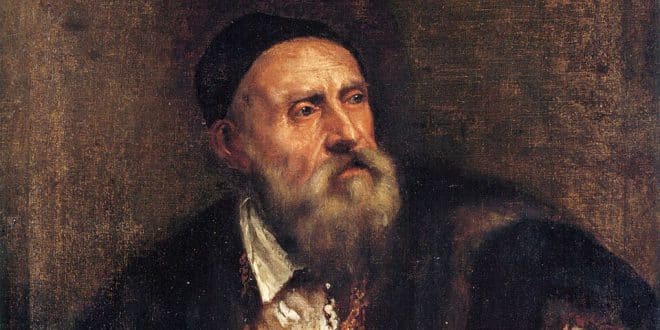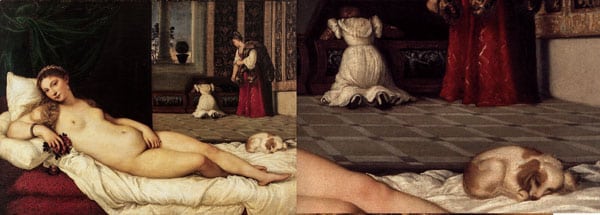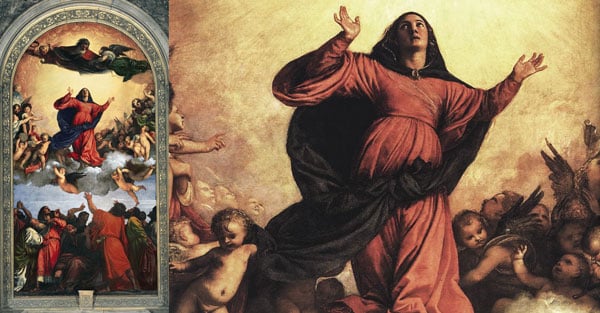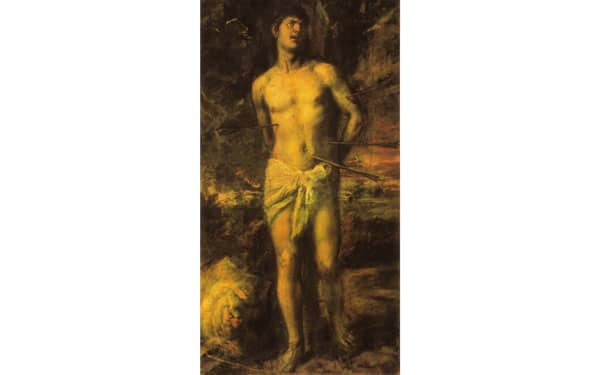“Divine”, “king of artists=, and the artist of kings” – this is how the outstanding Titian Vecellio was called by his contemporaries. The tremendous contribution of the Italian artist to world art cannot be underestimated. His personality became iconic for the High and Late Renaissance.
The master’s epic canvases depicting evangelic subjects and his colorful portraits of powerful people have become a standard in the fine arts and a source of admiration for several centuries.
Page Contents
Biography of Italian Artist
The painter-to-be was born in Pieve di Cadore, Belluno, a small town close to Venice. Unfortunately, there is no precise information about his date of birth, but it is considered to be around 1480 – 1490.
His family was of the middle class, and his father was involved in politics and military affairs. Little information has been left on the education of Titian, it is known only that he did not speak Latin and other ancient languages. However, knowledge of Latin was considered a sign of an educated and intelligent person. In his childhood, Titian was always drawing and painting. His parents noticed his talent, so the boy was sent to Venice at the age of 10-12 years old. Together with his brother, he was studying art.
The young Titian worked as an apprentice for several notable painters and sculptors, such as Gentile Bellini and later his brother Giovanni Bellini. The young artist met Giorgione, who later became his close friend and teacher. Besides, Lorenzo Lotto and other titans of the High Renaissance had a significant influence on his works.
Learning from his mentors the secrets of artistry, the laws of perspective, the peculiarities of composition, the gradation of light and color, Titian, who had an outstanding talent, developed his skills and, over time, acquired his own style.
At the very beginning of his career, the young painter received numerous orders from nobles and various religious fraternities. Titian’s popularity and recognition grew rapidly. At his 30th, he was officially declared as the first artist of the Republic of Venice (Serenissima Repubblica di Venezia).
The artist was married and had children (his wife, Cecilia Soldano, died when giving birth in 1530). He had a long and vivid careerallowed him to devote himself to painting for many decades. According to historians, Titian lived till 90-99 years, staying in good health and not ceasing to do what he loved. He died with a brush in his hand, in his own studio, in Venice from the plague that once again engulfed the city.
The body of the artist was not burnt as per the laws of that pandemic time, but buried according to Christian customs. You can find the tomb in the Basilica di Santa Maria Gloriosa dei Frari, one of the most important churches in the city. Two centuries later, on the orders of the Austrian Emperor Ferdinand I, a Baroque marble monument was created and established there.
Interesting facts about Tiziano Vecellio
There are plenty of interesting facts about Titian’s life, however most of them are myths. Nevertheless, here are several of true facts:
- Despite the lack of a fundamental education in human arts, the artist was part of the highest intellectual society of Venice, and for many years he was closely associated with Pietro Aretino, the famous Italian writer and satirist.
- Titian was characterized by cold prudence and even selfishness, thanks to which he not only never knew the need but also managed to earn a lot of money.
- The painter was a good enterpreneur.
- If one of the customers was delaying the payment, he flooded him with demanding letters (Emperor Philip II was not an exception despite their close friendship).
- The artist had a reputation of a great lover, and often spent time in the company of Venetian courtesans. Many of them posed for his paintings. The ideal of beauty was the lushly-bodied maiden with red hair.
- He married Cecilia Soldano, who had previously served as a housekeeper in the house of Titian, was his only official wife. He married her after she gave birth to two children together.
- Titian was noted for his thoroughness and leisurely approach to creating his masterpieces. If he the work was not successful, he postponed it until better times, regardless of the timing and agreements with customers, which often led to loud scandals.
Paintings of Titian Vecellio and peculiarities of his art
Titian was good in various genres of painting. He created about fifteen hundred paintings (not counting frescoes and engravings), leaving a rich artistic heritage remarkable for its versatility and depth of disclosure of the dramatic conflicts of the 16th century. Art historians distinguish three main periods in his work:
The early stage (the 20s of the XVI century the time of finding his own artistic style. Monumental canvases are created, which show the dynamism and scale of forms. The composition of paintings is built along the diagonal, which creates a sense of absolute reality and impetuous motion. The images are realistic, full of energy and love of life. A play of contrasts of bright color spots, attention to the smallest details, and thoroughness of drawing characterize Titian’s techniques. Feature also applies to the sensual, gentle women’s portraits.
The period of the highest blossoming of creative activity (30-40’s of the 16th century) – the period of acquiring universal recognition and national fame. The artist turns to portraits and landscapes from nature.
The traditional ceremonial portrait is transformed from a cold, formulaic image into a fascinating narrative about the life and inner world of the hero.
The later stage is a period of attaining the highest boldness and freedom in the visual arts. Images exude awe-inspiring vitality and drama. At the same time, one can distinctly feel tragic disappointment and awareness of the deep contradictions between the world around and the man. Many experts analyzing the artist’s late works, also note a certain carelessness and incompleteness of the paintings.
Venus of Urbino
In the 16th century, nobility was often ordering and presented paintings by prominent artists before marriage to future spouses. The Venere di Urbino is one of Titian’s most famous works, belonging to the genre of wedding portrait, executed in antique style.
The canvas (119 × 165 cm) depicts the ancient Greek goddess of love, shown as a golden-haired, exuberant Venetian, nude beauty with an open and sensual gaze. The lady lies in a relaxed pose, on a bed, in the luxurious interiors of the palace, waiting for the maid to choose her attire.
The painting was ordered by the Duke of Urbino, Guidobaldo II della Rovere (hence the title), in 1538 for his bride Giulia Varano. In addition to the evident eroticism exuded by Venus, the artist’s work contains symbols of the strength of the marriage bond: snow-white sheets and pillows, a little dog, and a myrtle near the window – all these represent the devotion and fidelity without which love is impossible. Titian’s magnificent painting is part of the treasury of the Galleria degli Uffizi in Florence.
The penitent Mary Magdalene
The subject matter of ‘The Penitent Mary Magdalene (Maddalena penitente)’ painting is one of the most common during the Renaissance. Titian created his masterpiece in the sixties of the 16th century. The artist’s heroine is staring into the sky, her eyes full of tears, her hand pressed to her chest, and the entire image is saturated with tremendous suffering and a prayerful plea for the forgiveness of past sins.
The biblical harlot who believed in Christ appears as a beautiful young woman filled with sorrow and love for the world and the Savior. Her half-naked shoulders and chest, sensual lips, and curls of golden hair exude the intensity of her inner feelings. The artist has reached the highest mastery in conveying the person’s emotional state. The figure of Magdalene is set against a background of nature: a gloomy cliff, a wind-tilted tree, and the evening sky illuminated by the reflections of the sunset. The landscape background, as well as the accompanying allegorical additions (an open book, a skull), enhance the general dramaticism of the work.
Danaë
The mythological painting Danaë is recognized by art historians as Titian’s most erotic work. During the 40-60’s of the 16th century, the artist created at least 5 copies of it. The plot is based on an ancient Greek epos that tells how King Acrisius of Argos imprisoned his only daughter Danaë, fearing her marriage and the appearance of an heir. According to the oracle’s prophecies, the girl was to bear a son by whose hand the ruler was to die. The beauty of the king’s daughter had seduced Zeus, who had come to the prisoner in a shower of gold. As a result, Perseus, the future hero, the famous hero, was born.
Titian’s first Danaë was painted roughly in 1544-1545, commissioned by the well-known collector and patron of the arts, Cardinal Alessandro Farnese. In this version of the work, a winged Cupid with a bow was placed at the feet of the ancient Greek beauty. In later copies of the painting (one of which was painted in 1553 at the request of King Philip II of Spain) instead of a small Cupid, an old nurse appeared, collecting gold coins. This gave additional deep meaning, concealed in the contrast of contradictions: youth – old age, beauty – ugliness, lofty love – selfishness.
Danaë’s nude figure remained unchanged in all versions of the painting. Her snow-white skin, her relaxed pose, speaking of passion and lust, and the blond curls falling on her firm chest became the most vivid embodiment of eroticism in painting. According to tradition, the masterly coloristic solution, the play of half-tones and shades, and the effect of the inner glow emanating from the heroine’s body were highly appreciated by Michelangelo di Buonarroti, who saw the work in Titian’s studio.
Assumption of the Virgin
The grandiose altarpiece Assumption of the Virgin Mary (Assunta) was painted by Titian in 1516-1518 and brought him universal acclaim.
The abbot of the cathedral of Santa Maria Gloriosa dei Frari, also called the Church of the Assumption of the Virgin Mary, commissioned the artist for a large-scale canvas (690 × 360 cm) in honor of the victory over the troops of the German Emperor Maximilian I, who had seized the possessions of the Republic of St. Mark. The majestic image of the Virgin Mary, which occupies the central place in the coon, represents Venice itself, reveling in triumph and freedom.
The plot is based on biblical legend, which tells of how the apostles, who preached in different parts of the world, gathered in Jerusalem to bury the body of the Virgin Mary, while the soul ascended to the heavenly realm, where it awaits reunion with the Creator. The emotional, sensual painting, distinguished by its unusual brilliance of colors, dynamism, play of color spots, vivid surrealistic figures, and majestic composition, is a true masterpiece of religious painting.
Throughout centuries, Titian’s work was placed on the main altar of Venetian cathedrals. The only exception was the period from 1818 to 1919, when the canvas was transferred to the Gallerie dell’Accademia. It is a well-known historical fact that Oscar Wilde, who saw the creation of Titian, called it the best painting in Italy.
I advise reading about: Sights of Venice
The Dinarium of Caesar
‘Cristo della moneta (The Dinarium of Caesar)’ is one of Titian’s most famous early works and was painted in 1516. Most likely, it was the customer of the painting, a shrewd politician, an expert in military affairs, the Duke of Ferrara Alfonso I d’Este, suggested to the artist a subject from a biblical text: the argument between Jesus Christ and the Pharisees. The moral of the Gospel parable was highly relevant to the ruler, who was endlessly trying to save his possessions from ecclesiastical authority and the pope’s influence on internal state affairs. Here everything is focused on the characters. The figures contrast with one another. the conflicts are intensified by the luminosity of the Savior’s image, which exudes kindness and moral rigor, and the gloominess of the colors and shadows of the Pharisee.
Christ’s refined fingers with the rough, wiry hand of his hypocritical antagonist, clutching a silver denarius, shows the spiritual difference of the two worlds. The depth of intent is conveyed through a masterful color scheme. Against the background of the Savior’s blue and red robes radiating a golden glow, the Pharisee’s white shirt seems dull and extinguished.
Now, you can find this artwork in Germany, in the treasury of the Dresden Picture Gallery.
Saint Sebastian
Deep emotionality, a symphony of colors, a harmony of forms, and fluidity of lines are included in one of the later works by Titian – ‘St. Sebastian’. It was created by the artist in the early 70s of the 16th century. The hero of the painting is a young legionary, a Roman archer who had secretly adopted and practiced the Christian faith and who was executed by Emperor Diocletian for the strength of his convictions. Various Renaissance painters often referred to the image of the Catholic martyr.
Titian’s work is the greatest outcome of the master’s creative quest. ‘St. Sebastian (San Sebastiano)’ is chained to a tree, suffering from pain, he stands in a majestic pose, maintaining composure and calmness. Titian’s Christian martyr is obsessed. He is tormented by prayer and fasting; he is a fine young man confronting evil and personifying fortitude, heroism, and courage. Flames of the fire burning in the background and the apocalyptic black sky merging with the earth intensify the atmosphere. The richness of colors is the primary tool of the master in embodying the artistic idea of the work.
According to legend, the painting remained in the house of Titian until his death. Since the 50’s of the XIX century, this artwork as well as some others, became part of the art collection of the State Hermitage Museum in St. Petersburg.
In the Galleria Borghese (Galleria Borghese) in Rome one can also see Titian’s painting “Sacred and Profane Love“, which contrasts in its subject matter the mundane and the sublime.
 Italy for me From Italy with love
Italy for me From Italy with love






